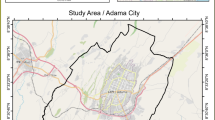Abstract
Valuation of infrastructure systems under climate change is a challenging issue because climate changes constantly and the influence of climate change is hardly predictable. Serious climate change effects can often be represented by frequent heavy rainfall events and floods. In response, municipalities should improve existing drainage systems to adapt to climate change. However, it is difficult to properly determine when or how to improve these systems because different investment strategies could result in entirely different outcomes. This study proposes a decision framework that can assist municipalities in identifying an optimal infrastructure investment strategy under climate change using a real option approach. The framework considers the uncertainties of climate change based on the volatility of flood damage and estimates the value of wait option for the improvement investment using binomial model. A case study is conducted to verify the proposed framework and assess how different investment strategies affect the value of a drainage system. The results showed that the system improvement with 100 year-flood design in 2019 was the most beneficial among available alternatives.





Similar content being viewed by others
References
Arisz H, Burrell B (2006) Urban drainage infrastructure planning and design considering climate change. EIC Climate Change Technology Conference, Ottawa
Ashley RM, Balmforth DJ, Saul AJ, Balnskby JD (2005) Flooding in the future—predicting climate change, risks and responses in urban areas. Water Science & Technology 52(5):265–273
Asuri B, Kashani H, Molenaar KR, Lee S, Liu J (2012) A risk-neutral pricing approach for evaluating bot highway projects with government minimum revenue guarantee options. Journal of Construction Engineering and Management 138(4):545–557
Brandao LET, Saraiva E (2008) The option value of government guarantees in infrastructure projects. Construction Management and Economics 26(11):1171–1180
Burrell BC, Davar K, Hughes R (2007) A review of flood management considering the impacts of climate change. Water International 32(3):342–359
Cheah CYJ, Liu J (2006) Valuing governmental support in infrastructure projects as real options using Monte Carlo simulation. Construction Management and Economics 24(5):545–554
Dewan SA, Smith RE (2005) Valuing pavement network assets and use of values as decision supports. Journal of Infrastructure Systems 11(4):202–210
de Neufville R, Scholtes S, Wang T (2006) Real option by spreadsheet: parking garage case example. Journal of Infrastructure Systems 12(2):107–111
Dobbes L (2010) Notes on applying ‘Real Options’ to climate change adaptation measures, with examples from Vietnam. Crawford School of Ecconomics and Government, Centre for Climate Economics & Policy. Australian National University, Canberra
Garvin MJ, Cheah CYJ (2004) Valuation techniques for infrastructure investment decisions. Construction Management and Economics 22(4):373–383
Godden L, Kung A (2011) Water law and planning frameworks under climate change variability: systemic and adaptive management of flood risk. Water Resources Management 25(15):4051–4068
Ho SP, Liu LY (2002) An option pricing-based model for evaluating the financial viability of privatized infrastructure projects. Construction Management and Economics 20(2):143–156
Jung I, Bae D, Kim G (2011) Recent trends of mean and extreme precipitation in Korea. International journal of climatology 31:359–370
Kim B (2009) Adaptation strategies for extreme flood to cope with future climate change. Journal of Korean society of civil engineers 57(9):27–41
Kim B, Lim HS, Kim H, Hong T (2012) Determining the value of governmental subsidies for the installation of clean energy systems as real options. Journal of Construction Engineering and Management 138(3):422–430
Lee S, Yeo C (2011) A study on estalbishment of disaster paradigm against extreme weather. Seoul Development Institute, Seoul
Michailidis A, Mattas K (2007) Using real options theory to irrigation dam investment analysis: an application of binomial option pricing model. Water Resources Management 21(10):1717–1733
Michailides A, Mattas K, Tzouramani I, Karamouzis D (2009) A socioeconomic valuation of an irrigation system project based on real option analysis approach. Water Resources Management 23(10):1989–2001
Park T, Kim B, Kim H (2012) Impact of deterioration and negotiation on sewer system O & M contracts from the real option perspective. Water Resources Management 26(10):2973–2989
Short M, Peirson W, Peters G, Cox R (2012) Managing adaptation of urban water systems in a changing climate. Water Resources Management 26(7):1953–1981
Suttinon P, Nasu S (2010) Real options for increasing value in industrial water infrastructure. Water Resources Management 24(12):2881–2892
Trigeorgis L (1996) Real options: managerial flexibility and strategy in resource allocation. MIT Press, Boston
Woodward M, Gouldby B, Kapelan Z, Khu S, Townend I (2010) Incorporating real options into flood risk management decision making. 14th annual international real options conference
Won H, Lee S (2011) The protection of urban flood with 100-year design drainage system. The Kyunghyang Newspaper, 29(July)
World Bank (2010) Economics of adaptation to climate change: Synthesis report. Washington, DC
Zhao T, Tseng C (2003) Valuing flexibility in infrastructure expansion. Journal of Infrastructure Systems 9(3):89–97
Zhou Q, Mikkelsen PS, Halsnæs K, Arnbjerg-Nielsen (2012) Framework for economic pluvial flood risk assessment considering climate change effect and adaptation benefits. Journal of Hydrology 414:539–549
Acknowledgments
This work was supported by grants (2011-0030841) from the National Research Foundation and Ministry of Education, Science, and Technology of Korea. This work was also supported by “BIM/GIS Platform based Construction Project Management Technology” from Korea Institute of Construction Technology.
Author information
Authors and Affiliations
Corresponding author
Rights and permissions
About this article
Cite this article
Park, T., Kim, C. & Kim, H. Valuation of Drainage Infrastructure Improvement Under Climate Change Using Real Options. Water Resour Manage 28, 445–457 (2014). https://doi.org/10.1007/s11269-013-0492-z
Received:
Accepted:
Published:
Issue Date:
DOI: https://doi.org/10.1007/s11269-013-0492-z




